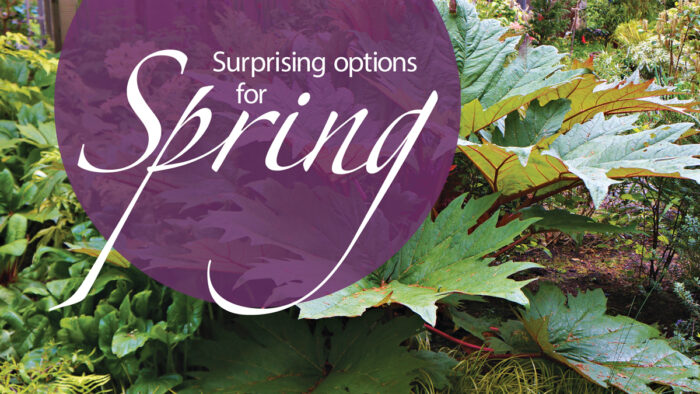
For those of us in temperate climates, spring is a wonderful time of the year. There is a palpable energy and excitement in both garden and gardener as gray and brown transform to green and as flowers in all the colors of the rainbow burst into bloom. I imagine that when asked to picture a garden in spring, many envision drifts of daffodils, tulips, and hyacinths skirting the trunks of flowering magnolias, cherries, and lilacs. There is no denying the appeal of kaleidoscopic spring bulbs and their carefree color and fragrance. However, especially in the shade garden, there are many other flowering perennials, ranging from the spectacular to the sublime, that can add depth and nuance to any spring display.
Get early-season impact from these larger options
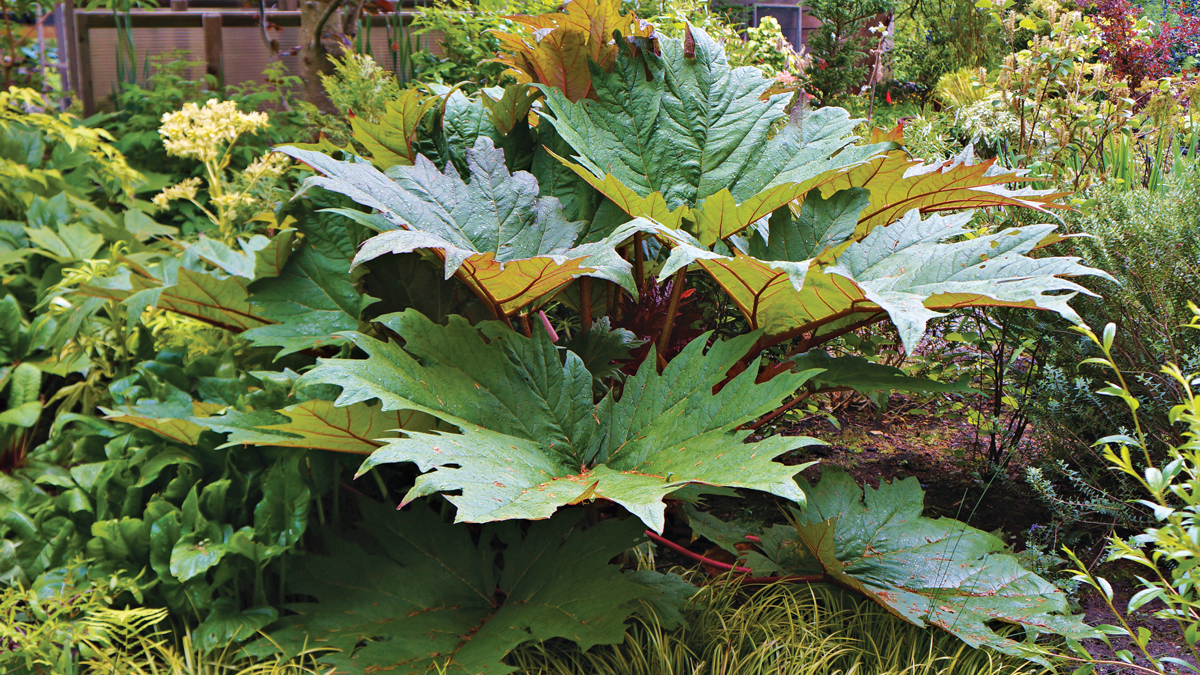
Ornamental rhubarb packs a punch
Name: Rheum palmatum var. tanguticum and cvs.
Zones: 3–9
Size: 6 feet high and 5 feet wide
Conditions: Full sun to partial shade; average to moist soil
Native range: China
Large leaves stand out in the garden, and few big-leaved plants can outdo the impact of red-foliaged forms of ornamental rhubarb. Crinkled, baseball-size buds appear almost overnight in early spring and quickly expand into shaggy, 2-foot-wide leaves. This dramatic species is typically grown from seed, so the level of burgundy saturation varies from plant to plant. Though this species is not edible, it prefers the same conditions as the common rhubarb: abundant moisture in spring, moderate summer temperatures, and partial shade to full sun. Its flowers are reddish pink and borne on thick, 4- to 6-foot plumes.

Umbrella leaf has a bold habit, but it behaves
Name: Diphylleia cymosa
Zones: 6–8
Size: 3 to 4 feet tall and 5 to 6 feet wide
Conditions: Partial shade; moist soil
Native range: Southern Appalachian Mountains
Another of my springtime favorites is umbrella leaf from the southern Appalachians. The paired leaves grow as big as dinner plates on 2- to 3-foot petioles that spring from a clumping rhizome. Umbrella leaf is related to mayapple (Podophyllum spp., Zones 3–8) but lacks the latter’s insatiable wanderlust. If you appreciate mayapple’s bold foliage but not its spreading habit, then give umbrella leaf a try. In shade and moist to wet soil, it can grow to massive proportions after several years. The leaves emerge quickly from the warming ground, at first resembling little closed umbrellas with a ruddy hue. As the foliage expands, the umbrellas split in two to reveal clusters of flower buds nestled within. Balls of white flowers bloom atop a sea of foliage in midspring. They are pretty but not spectacular, but if the bumblebees do their job, blueberry-colored berries on brilliant scarlet stems follow in summer. As fall approaches, the leaves turn orange and yellow as if not to be outdone.
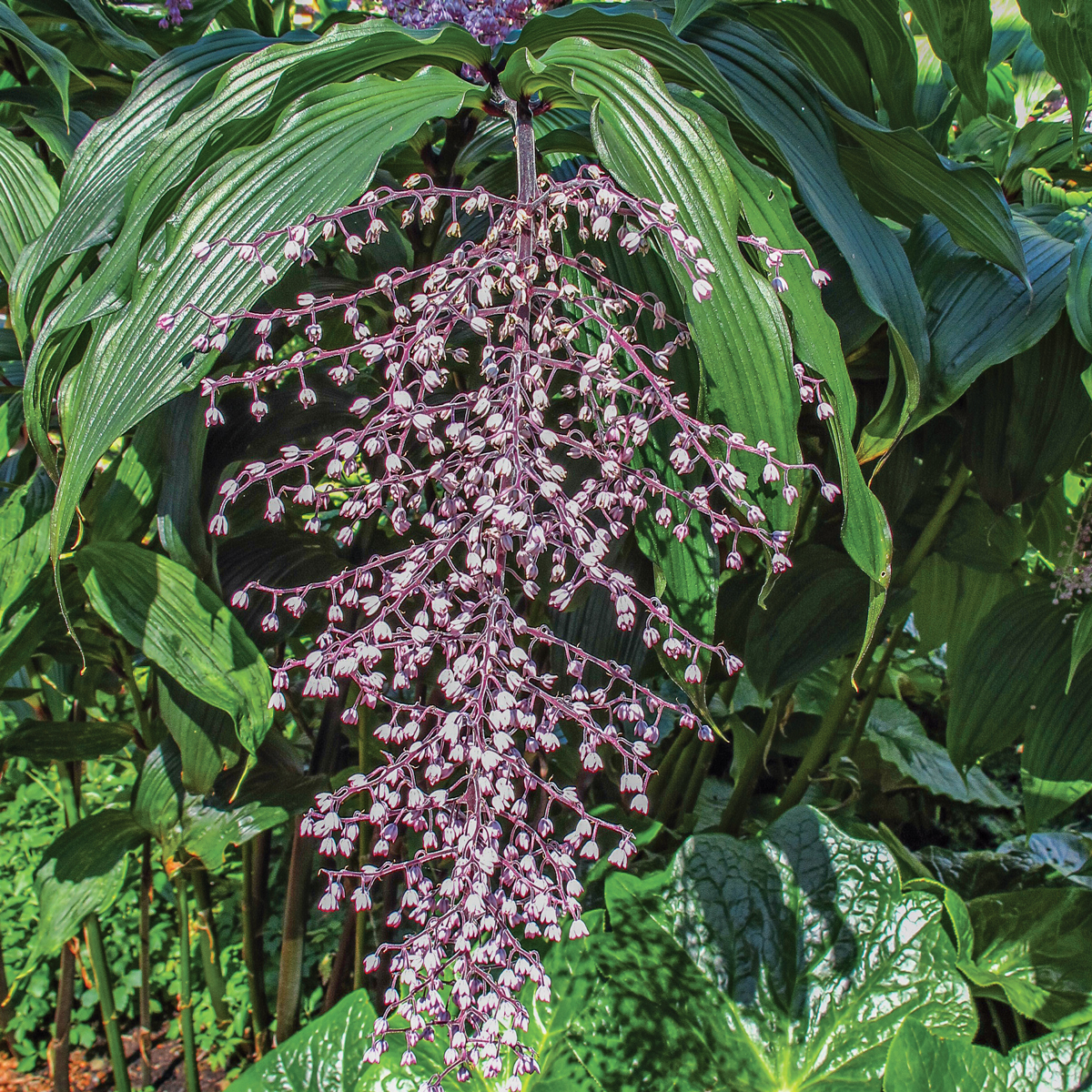
Asian false Solomon’s seal lights up the shade
Name: Maianthemum oleraceum
Zones: 6–9
Size: 3 to 4 feet tall and 2 feet wide
Conditions: Partial shade; average to moist soil
Native range: Southeastern Asia
One of the most remarkable shade perennials I have ever seen has a most unremarkable common name. Asian false Solomon’s seal is a close cousin to our native false Solomon’s seal (Maianthemum racemosum, Zones 3–8), with two ranked, pleated leaves lining 3- to 4-foot arching stems that spring from a thick, subterranean rhizome. The stem is often tinged red or even deeper, almost blackish red, and this color carries up into the stems and even into the flowers that dangle like clusters of pure white, pink, or bluish-purple grapes from the stem tips. It is as if someone had crossed a Solomon’s seal with an astilbe (Astilbe spp. and cvs., Zones 3–8) in order to pair the lovely foliage arrangement of the former with the soft plumelike flowers of the latter. Asian false Solomon’s seal prefers dappled shade and well-drained, humus-rich soil.
Medium-size options dazzle without demanding much room
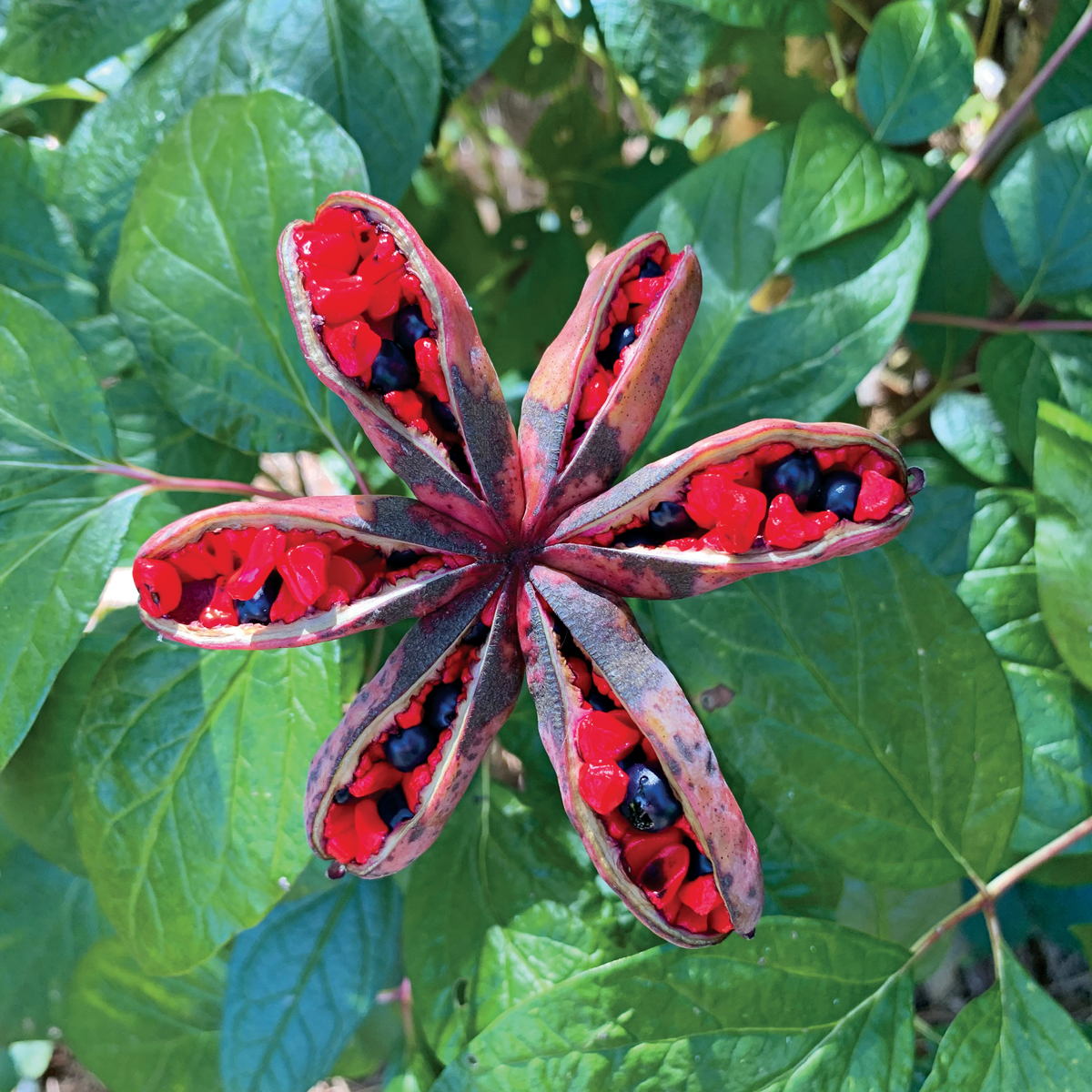
Japanese forest peony is about more than the blooms
Name: Paeonia obovata
Zones: 5–8
Size: 2 feet tall and wide
Conditions: Partial shade; well-drained soil
Native range: Eastern Asia
Garden peonies (Paeonia cvs., Zones 3–8) have been hybridized and selected for generations to favor huge double blooms that require staking and caging so the plants do not simply topple over from their immense weight. Of course, wild peonies are far more demure, with single blooms that are easily supported by the stems without human intervention. Japanese forest peony is a shade-tolerant, white- to pink-flowered species that blooms about a month before the common garden peonies. Each leafy stem supports a single, teacup-shaped, crinkled bloom. Peer inside to discover a boss of golden anthers supported by beet red filaments that give the flower a smoldering glow. If you plant more than one, the flowers will yield three to six pods arranged in a circle that split open in fall to reveal startling metallic blue berries nestled among scarlet kernels (the unfertilized seeds).
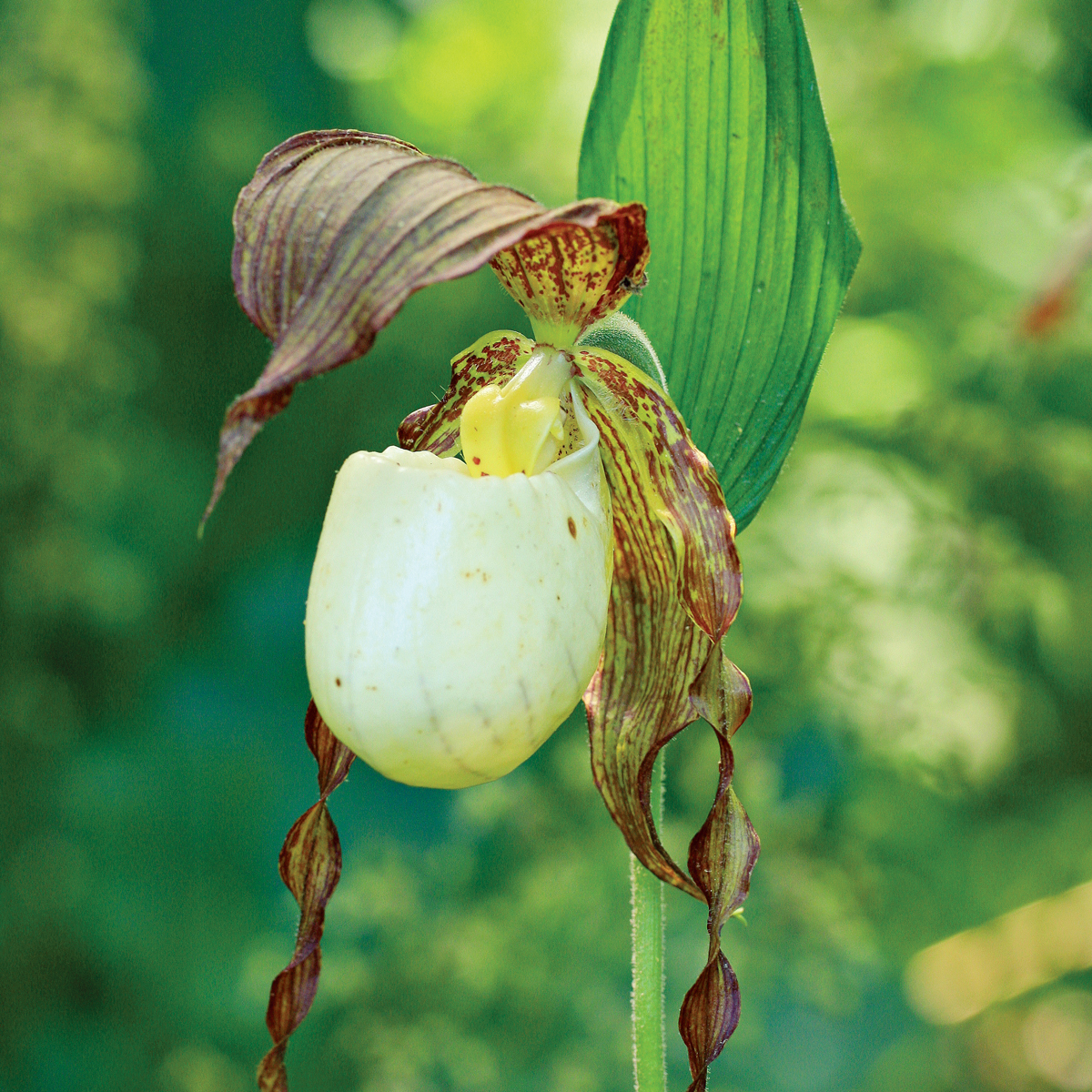
Kentucky lady’s slipper is tougher than you think
Name: Cypripedium kentuckiense
Zones: 3–8
Size: 24 inches tall and 18 inches wide
Conditions: Partial shade; moist soil
Native range: Southeastern United States
Lady-slipper orchids are as enigmatic as they are spectacular. Their difficult reputation is largely deserved, though a few species are easy to cultivate if you give some care to siting and establishment. If you have a lightly shaded spot, I recommend giving Kentucky lady’s slipper a try. This vigorous, 2-foot-tall orchid produces remarkable soft yellow slippers as big as hen’s eggs, with a contrasting burgundy hood and long, mustachioed petals. The plants grow from a nest of ramen noodle roots that send up stems of four to six pleated leaves, each supporting one flower. Under good conditions, blooming-sized plants can double in size every year. Mulch the shallow roots with chopped leaves in the fall to protect them from winter’s drying winds and cold.
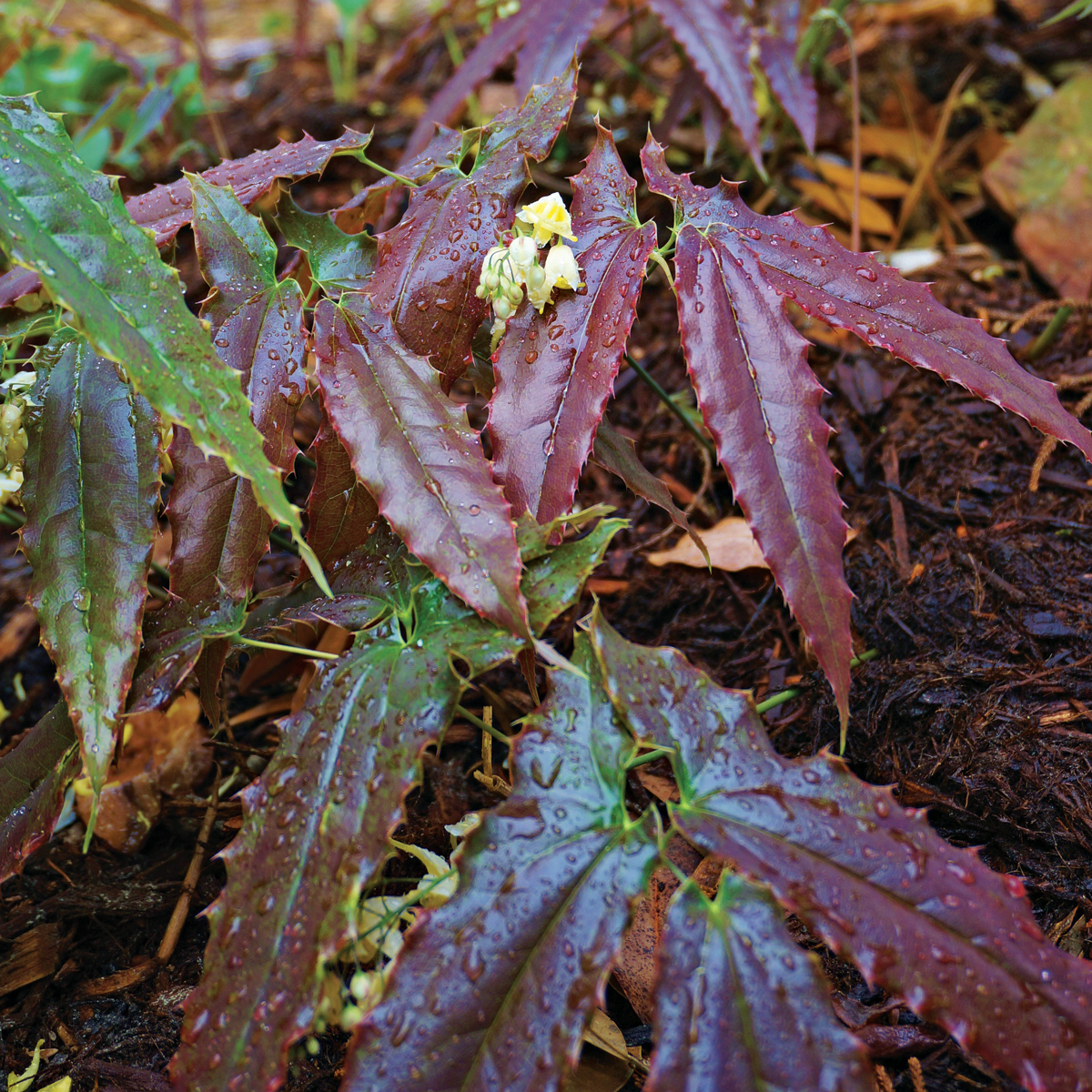
Wushan epimedium has a unique look
Name: Epimedium wushanense and cvs.
Zones: 5–9
Size: 1 foot tall and 3 feet wide
Conditions: Partial shade; well-drained soil
Native range: China
Epimediums (Epimedium spp. and cvs., Zones 4–9) are tough, drought- and deer-resistant shade perennials. Most garden varieties are selections and hybrids of Japanese species that were bred mainly for flower color and shape. In the 1990s, a flood of “new” species from China started to enter Western horticulture and greatly expanded the variety of available forms. One of the most unique is the evergreen Wushan epimedium, with long, fingered leaves that spread out elegantly in all directions. Young leaves are burgundy, fading to light green and then deep, glossy green as they mature. Both spiny and smooth-leaved forms are available, though I prefer the former, as the holly-like spines add texture to a composition. Dense clusters of butter-and-eggs-colored flowers dangle amid the emerging leaves in spring.
Smaller plants have the power to delight any gardener
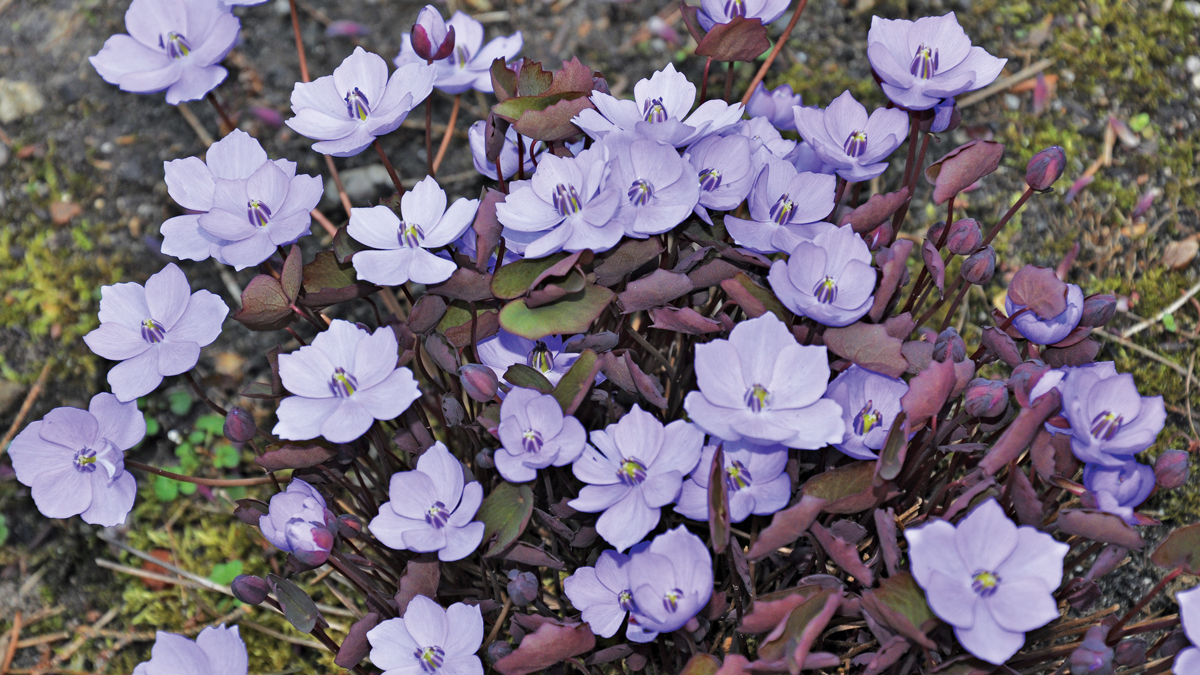
Asian twinleaf starts the season off with charm
Name: Plagiorhegma dubium (syn. Jeffersonia dubia)
Zones: 4–7
Size: 12 inches tall and 8 inches wide
Conditions: Partial to full shade; moist, slightly acidic, well-drained soil
Native range: Korea
As the ground warms in early spring, one of the first perennials to emerge in my shade garden is the exquisite Korean wildflower Asian twinleaf. This is a rare plant in nature, occurring in rich woodlands throughout the Korean peninsula and over the border into China and Russia. A close relative of our native twinleaf (Jeffersonia diphylla, Zones 5–7), Asian twinleaf puts on a sublimely beautiful, albeit brief, floral display. The upward-facing chalices range in shade from pale violet to an ethereal deep violet-blue, and they rest just above the scalloped, saucer-shaped leaves in the manner of tiny waterlilies. The darker the flower, the darker also are the emerging leaves, which open like burgundy scallop shells to the vernal sun.
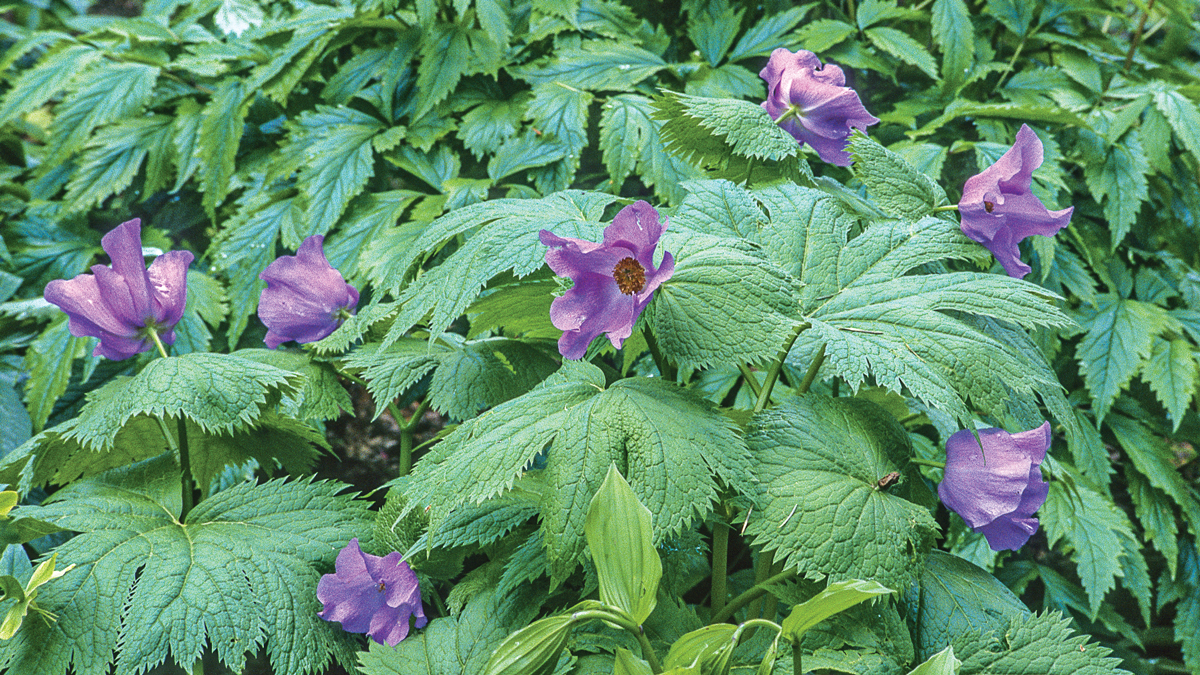
Japanese wood poppy is worth the wait
Name: Glaucidium palmatum
Zones: 3–7
Size: 16 inches tall and 18 to 24 inches wide
Conditions: Partial to full shade; average to moist soil
Native range: Japan
Across the Sea of Japan in the mountains of northern Honshu and Hokkaido grows another incredible woodlander with flowers of a similar hue. Japanese wood poppy does resemble a poppy in overall shape, its large petals cupping a nest of golden anthers cradling a two-lobed stigma that sits like a pair of little golden eggs within. Long considered a relative of peonies, this uncommon species is now placed within the buttercup family. The smoky violet, 3-inch blooms are composed of four petals that stack in pairs much like dogwood flowers. Each flower sits atop a 12- to 16-inch stem of three maple-shaped leaves. The two lower leaves are as big as a hand and appear paired, while a smaller one fringes the flower itself like an elaborate green collar. Japanese wood poppy is not for the impatient gardener. It takes three to four years for a seedling to bloom and an equal amount of time for the clump to fully mature. However, from there it will continue to grow larger and more resplendent each spring.
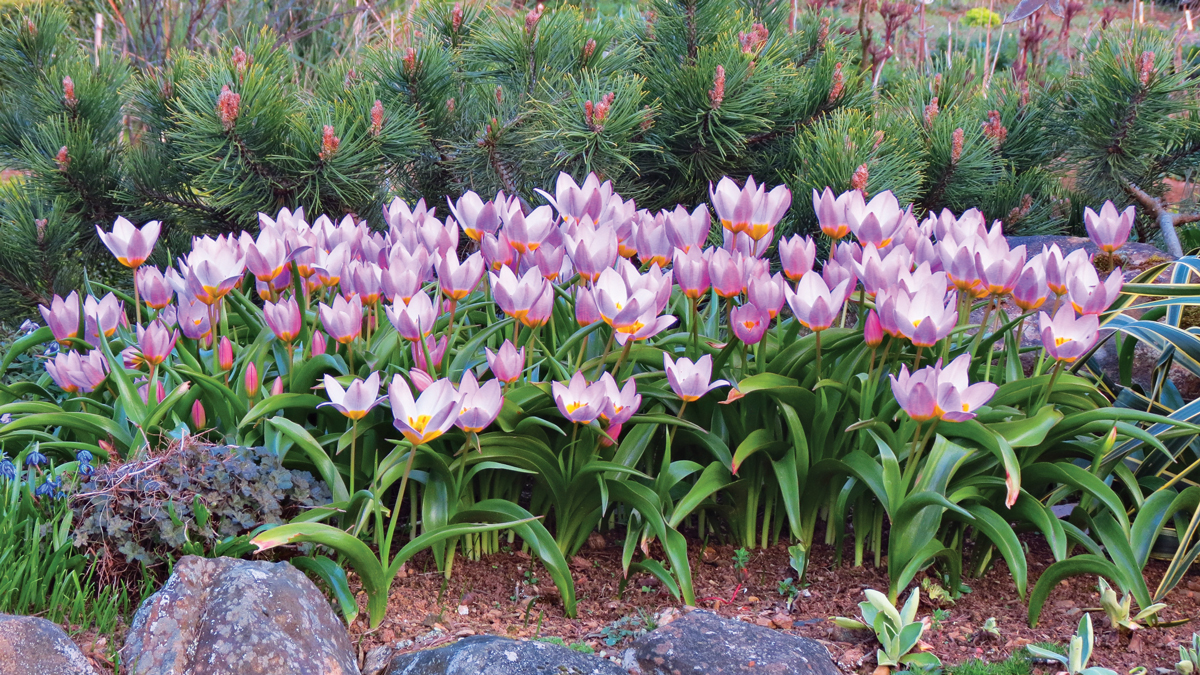
‘Lilac Wonder’ isn’t your average tulip
Name: Tulipa bakeri ‘Lilac Wonder’
Zones: 4–8
Size: 6 inches tall and 3 inches wide
Conditions: Full sun to partial shade; well-drained soil
Native range: Greece and Turkey
Finally, if you love the convenience of bulbs but are searching for something a bit different from the typical tulip or run-of-the-mill daffodil, consider ‘Lilac Wonder’ tulip, a perennial species tulip. This demure selection sports thin leaves that support single flowers of soft pink to lavender, contrasting with a bright golden circle inside to suggest an egg yolk sitting in a rosy saucer. Plant this cheery tulip in clumps of five to seven for better effect, and allow the leaves to completely wither after flowering before removing them to ensure that the bulb will return next year.
William Cullina is the executive director of the Morris Arboretum in Philadelphia.
Sources
- Digging Dog, Albion, CA; 707-937-1130; diggingdog.com
- Far Reaches Farm, Port Townsend, WA; 360-385-5114; farreachesfarm.com
- Plant Delights Nursery, Raleigh, NC; 919-772-4794; plantdelights.com
- White Flower Farm, Litchfield, CT; 800-503-9624; whiteflowerfarm.com
Fine Gardening Recommended Products

Pruning Simplified: A Step-by-Step Guide to 50 Popular Trees and Shrubs
Fine Gardening receives a commission for items purchased through links on this site, including Amazon Associates and other affiliate advertising programs.

ARS Telescoping Long Reach Pruner
Fine Gardening receives a commission for items purchased through links on this site, including Amazon Associates and other affiliate advertising programs.

Planting in a Post-Wild World: Designing Plant Communities for Resilient Landscapes
Fine Gardening receives a commission for items purchased through links on this site, including Amazon Associates and other affiliate advertising programs.


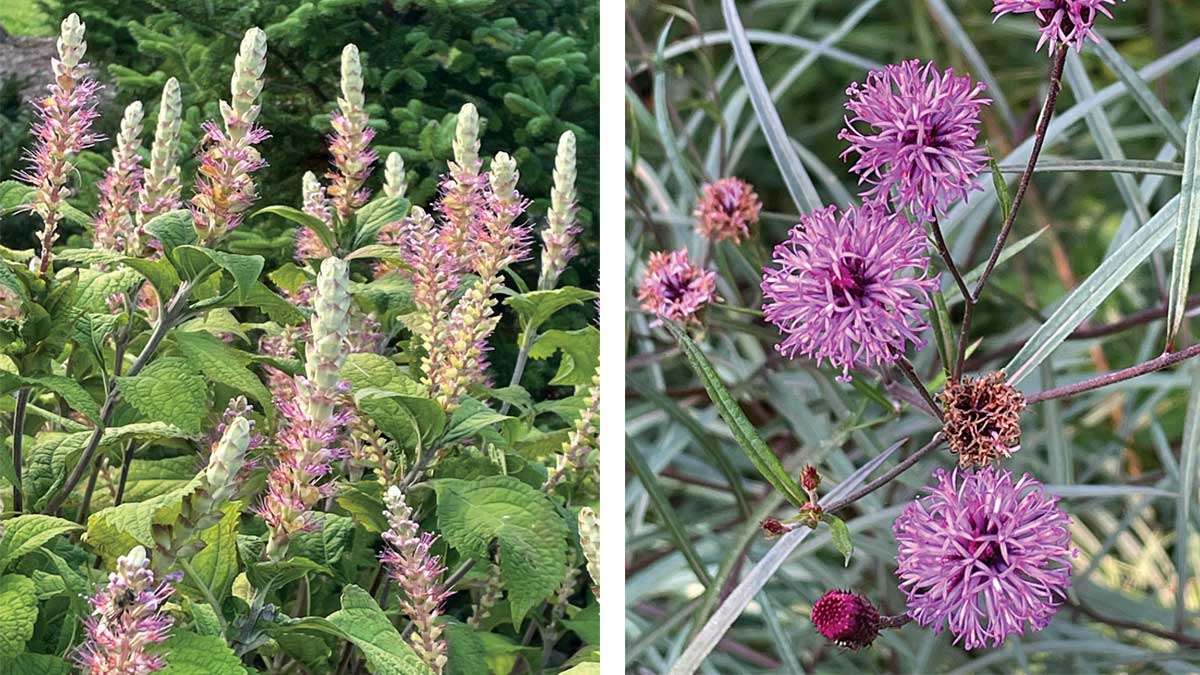
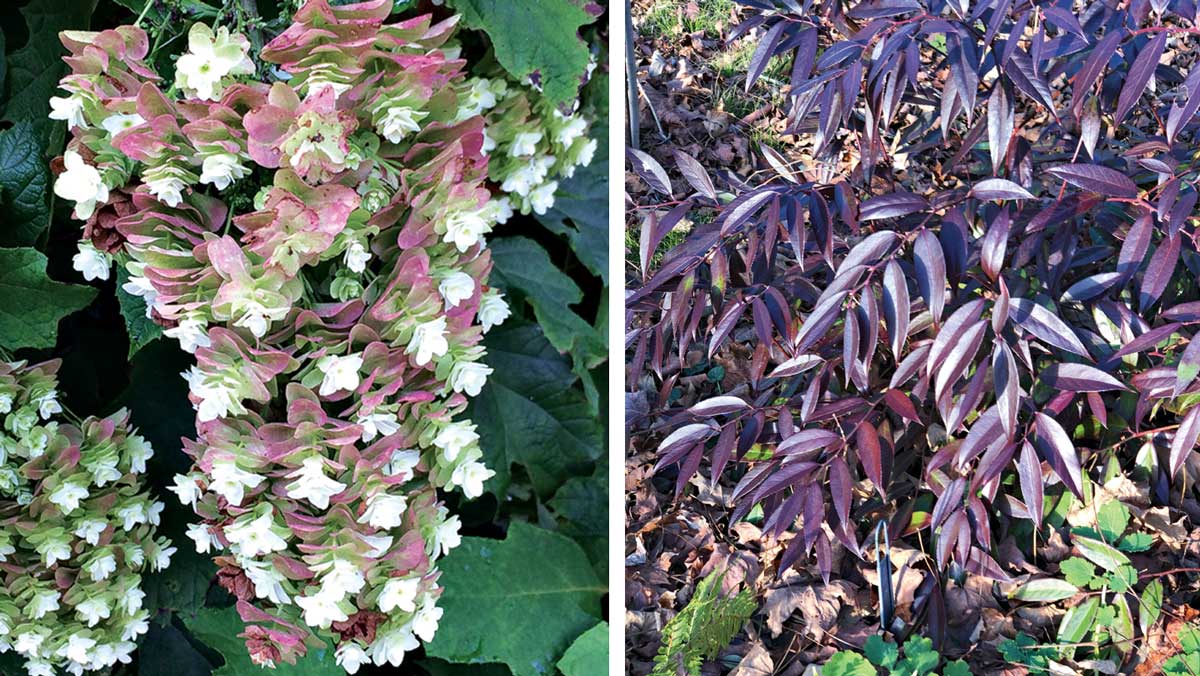














Comments
Still wondering why you promote so many non-native plants - when Fine Gardening has featured so many authors emphasizing that natives are crucial to sustaining pollinators and wildlife. You mention only 2 natives here. What about native False Solomon's Seal, Golden Alexanders, Native Columbine, Native Geranium, Merrybells, Virginia Bluebells, Jacob's Ladder, Celandine Poppy, Bleeding Heart, Native Twinleaf, not to mention all the spring ephemerals?
Log in or create an account to post a comment.
Sign up Log in